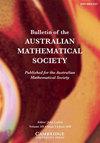COUNTING UNIONS OF SCHREIER SETS
IF 0.5
4区 数学
Q3 MATHEMATICS
引用次数: 0
Abstract
A subset of positive integers施赖尔集合的计数联合
如果一个正整数子集 F 是非空的,并且 $|F|leqslant \min F$(这里 $|F|$ 是 F 的万有引力),那么它就是施赖耶集。对于每个正整数 k,我们定义 $k\mathcal {S}$ 为最多 k 个施赖尔集合的所有联合的集合。另外,对于每个正整数 n,让 $(k\mathcal {S})^n$ 成为 $k\mathcal {S}$ 中最大元素等于 n 的所有集合的集合。众所周知,序列 $(|(1\mathcal {S})^n|)_{n=1}^\infty $ 就是斐波那契序列。特别是,该序列满足线性递推。我们证明了序列 $(|(kmathcal {S})^n|)_{n=1}^infty $ 满足每一个正 k 的线性递归。
本文章由计算机程序翻译,如有差异,请以英文原文为准。
求助全文
约1分钟内获得全文
求助全文
来源期刊
CiteScore
1.20
自引率
14.30%
发文量
149
审稿时长
4-8 weeks
期刊介绍:
Bulletin of the Australian Mathematical Society aims at quick publication of original research in all branches of mathematics. Papers are accepted only after peer review but editorial decisions on acceptance or otherwise are taken quickly, normally within a month of receipt of the paper. The Bulletin concentrates on presenting new and interesting results in a clear and attractive way.
Published Bi-monthly
Published for the Australian Mathematical Society

 求助内容:
求助内容: 应助结果提醒方式:
应助结果提醒方式:


